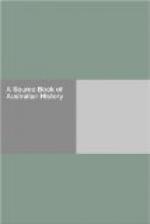LANDING ON GALLIPOLI
+Source.+—–Dispatch from a special Correspondent at the Dardanelles printed in The Times, 7 May 1915
Soon after the commencement of the war Turkey joined the Central Powers, and consequently the Australian Imperial Forces, having experienced a rigorous training in Egypt, were used to assist the Navy and other Allied troops in an attempt to force the Dardanelles.
VIEWED FROM A BATTLESHIP
Slowly through the night of April 24th our squadron, which was to land the covering forces of the Australian contingent just north of Gaba Tepe, steamed towards its destination....
At 1 a.m. the ships arrived off their appointed rendezvous, five miles from the landing-place, and stopped. The soldiers were aroused from their slumbers, and were served with a last hot meal. A visit to the mess decks showed these Australians, the majority of whom were about to go into action for the first time under the most trying circumstances, possessed at 1 o’clock in the morning courage to be cheerful, quiet, and confident....
At 1.20 a.m. the signal was given from the flagship to lower the boats, which had been left swinging from the davits throughout the night. Our steam pinnaces were also lowered to take them in tow....
On the quarter-deck, backed by the great 12 in. guns, this splendid body of colonial troops were drawn up in serried ranks, fully equipped, and receiving their last instructions from their officers, who, six months ago, like their men, were leading a peaceful civilian life in Australia and New Zealand, 5,000 miles away....
At 2.5 a.m. the signal was given for the troops to embark in the boats which were lying alongside, and this was carried out with great rapidity, in absolute silence, and without a hitch or an accident of any kind....
The whole operation had been timed to allow the pinnaces and boats to reach the beach just before daylight, so that the Turks, if they had been forewarned, would not be able to see to fire before the Australians had obtained a firm footing and, it was hoped, good cover on the foreshore....
At 4.53 a.m. there suddenly came a very sharp burst of rifle fire from the beach, and we knew our men were at last at grips with the enemy. This fire lasted only for a few minutes, and then was drowned by a faint British cheer wafted to us over the waters....
The first authentic news we received came with the return of our boats. A steam pinnace came alongside with two recumbent forms on her deck and a small figure, pale, but cheerful, and waving his hand astern. They were one of our midshipmen, just sixteen years of age, shot through the stomach, but regarding his injury more as a fitting consummation to a glorious holiday ashore than a wound; and a chief stoker, and petty officer, all three wounded by that first burst of musketry, which caused many casualties in the boats just as they reached the beach.




